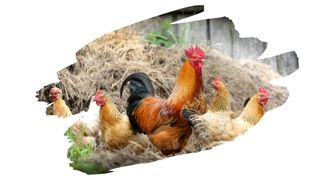The safest wood you can make a coop from is always going to be untreated and free of wood preservatives. Which makes sense, since natural solid timber won’t have been infused with any worryingly harsh chemicals.
But, then again, pressure treated wood is more suited for outdoor structures. Especially as it is more rot-resistant than untreated timber.
So, how worried should you really be about using pressure treated wood around your chickens?
Well, in this post, we reveal what really goes into the chemical treatments found in pressure treated wood. You will also learn what green treated wood is — and why these specially treated timbers can be a much safer alternative.

This post may contain affiliate links to products that we receive a commission for (at no additional cost to you). Learn more here.
Is Pressure Treated Wood Really That Toxic?
It mostly depends on which chemicals have been used to treat that lumber.
You see, pressure treated wood will have been infused with rot-resistant wood preservatives. And those chemical preservatives act like a fungicide, as they fight off the bacteria responsible for wood rot.
But, the stuff used to make most of those wood preserving treatments are toxic. In fact, some pressure treatment preservatives — such as Chromated copper arsenate (CCA) — even contain arsenic.
Now, there is nothing wrong with using these preservatives to help protect wood from decay. Which is why most exterior timbers — especially ones that’ll have prolonged contact with the ground — will often have been pressure treated.
But, those self-same wood preservatives can leach out of wood — particularly in humid climates. So, the last thing you want is to have any treated wood inside the humid environment of a coop.
What’s more, your chickens can peck at the wooden walls of their coop. So this increases the risk of those chemical wood preservatives getting on your chickens.
Related Post: Railroad Ties Vs Pressure Treated Fence Posts: Which One’s Best For Your Garden?
Are There Any Safe Pressure Treated Timbers Out There?
Well, there are special kinds of pressure treated wood called ‘Green Treated’ wood.
These green treated timbers get put through an infusion pressure treatment the way all treated timbers do. However, green treated wood has been saturated with much safer wood preservatives, such as Alkaline Copper Quaternary (also referred to as ACQ).
Now, ACQ does a great job at fighting off wood rot. And this is down to the fact that there’s a lot of copper sloshing around in this water-soluble preservative.
That copper is also the reason why ‘green treated’ wood gets referred to as such. The green-hue of green treated wood is due to copper oxidizing (i.e. reacting to the oxygen in the air).
Related Post: How To Dry Pressure Treated Wood (Quickly And Without Warping)
So Is Green Pressure-Treated Wood Safe Around Farm Animals?
Green treated wood is more of a ‘least-toxic’ treated wood, rather than a ‘completely-safe’ one.
ACQ treated wood, specifically, is one of the least toxic wood preserving treatments of them all. Which is why the E.P.A.’s (U.S. Environmental Protection Agency), guidelines state that ACQ treated wood is safe to use in and around your garden.
What’s more, the copper in ACQ isn’t a wholly worrisome chemical additive either, (unlike the arsenate found in CCA treatments).
Related Post: How To Keep Your Landscape Timbers From Ever Warping Again
Is The Copper In ACQ Treated Wood Safe Around Chickens?
The copper (namely Copper Sulfate), commonly used by chicken farmers is a water-sanitizing antimicrobial. However, the copper found inside ACQ is a world away from that.
ACQ treatments contain Copper Oxide (also known as Cupric Oxide). This is the type of copper that’s sometimes added to some over-the-counter multivitamins.
So, ACQ green treated wood is a low-risk treated wood. And it can be used around both humans and animals.
Nevertheless, when it comes to pressure treated wood, safety is relative. And, if you want to be certain of your chickens health, then it’s not a good idea to use even green treated wood for a coop.
To Wrap Up, Here Are The 3 Key Takeaways From This Post…
- 1). Most pressure treated wood will have been infused with chemical wood preservatives. These chemical preservatives are often toxic, and much too dangerous to have around your chickens.
- 2). Green-treated wood is pressure treated wood that has been treated with ‘garden-friendly’ chemical wood preservatives.
- 3). Green-treated wood is much safer than regular pressure treated timber. However, it is still not recommended you use it for making a chicken coop.
References:
C A Cushing, R Golden, Y W Lowney, S E Holm (2007): “Human Health Risk Evaluation of ACQ-Treated Wood“. Journal Human and Ecological Risk Assessment, volume 13, issue 5, pages 1014-1041.
Toxicity Concerns about Raised Bed Construction Materials | Iowa State University
